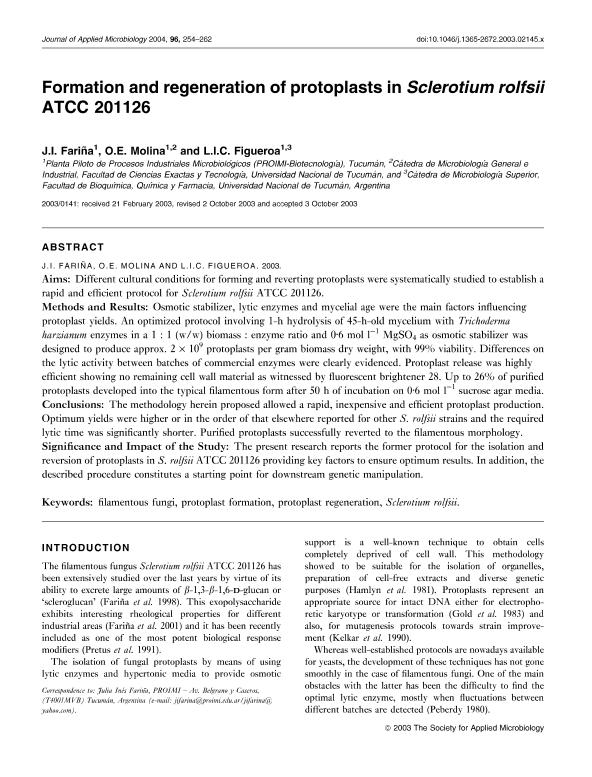Mostrar el registro sencillo del ítem
dc.contributor.author
Fariña, Julia Ines

dc.contributor.author
Molina, Oscar Edberto

dc.contributor.author
Castellanos, Lucia Ines

dc.date.available
2018-04-13T18:09:23Z
dc.date.issued
2004-02
dc.identifier.citation
Fariña, Julia Ines; Molina, Oscar Edberto; Castellanos, Lucia Ines; Formation and regeneration of mycelial protoplasts from Sclerotium rolfsii: A novel procedure for manipulating scleroglucan production?; Wiley Blackwell Publishing, Inc; Journal of Applied Microbiology; 96; 2; 2-2004; 254-262
dc.identifier.issn
1364-5072
dc.identifier.uri
http://hdl.handle.net/11336/41992
dc.description.abstract
Aims: Different cultural conditions for forming and reverting protoplasts were systematically studied to establish a rapid and efficient protocol for Sclerotium rolfsii ATCC 201126.
Methods and Results: Osmotic stabilizer, lytic enzymes and mycelial age were the main factors influencing protoplast yields. An optimized protocol involving 1-h hydrolysis of 45-h-old mycelium with Trichoderma harzianum enzymes in a 1:1 (w/w) biomass : enzyme ratio and 0Æ6 mol l)1 MgSO4 as osmotic stabilizer was designed to produce approx. 2x 109 protoplasts per gram biomass dry weight, with 99% viability. Differences on the lytic activity between batches of commercial enzymes were clearly evidenced. Protoplast release was highly efficient showing no remaining cell wall material as witnessed by fluorescent brightener 28. Up to 26% of purified protoplasts developed into the typical filamentous form after 50 h of incubation on 0Æ6 mol l)1 sucrose agar media.
Conclusions: The methodology herein proposed allowed a rapid, inexpensive and efficient protoplast production. Optimum yields were higher or in the order of that elsewhere reported for other S. rolfsii strains and the required lytic time was significantly shorter. Purified protoplasts successfully reverted to the filamentous morphology. Significance and Impact of the Study: The present research reports the former protocol for the isolation and reversion of protoplasts in S. rolfsii ATCC 201126 providing key factors to ensure optimum results. In addition, the described procedure constitutes a starting point for downstream genetic manipulation.
dc.format
application/pdf
dc.language.iso
eng
dc.publisher
Wiley Blackwell Publishing, Inc

dc.rights
info:eu-repo/semantics/openAccess
dc.rights.uri
https://creativecommons.org/licenses/by-nc-sa/2.5/ar/
dc.subject
Sclerotium Rolfsii
dc.subject
Filamentous Fungi
dc.subject
Protoplast Formation
dc.subject
Protoplast Regeneration
dc.subject.classification
Otras Ciencias Biológicas

dc.subject.classification
Ciencias Biológicas

dc.subject.classification
CIENCIAS NATURALES Y EXACTAS

dc.title
Formation and regeneration of mycelial protoplasts from Sclerotium rolfsii: A novel procedure for manipulating scleroglucan production?
dc.type
info:eu-repo/semantics/article
dc.type
info:ar-repo/semantics/artículo
dc.type
info:eu-repo/semantics/publishedVersion
dc.date.updated
2018-04-10T13:53:46Z
dc.journal.volume
96
dc.journal.number
2
dc.journal.pagination
254-262
dc.journal.pais
Reino Unido

dc.journal.ciudad
Londres
dc.description.fil
Fil: Fariña, Julia Ines. Consejo Nacional de Investigaciones Científicas y Técnicas. Centro Científico Tecnológico Conicet - Tucumán. Planta Piloto de Procesos Industriales Microbiológicos; Argentina
dc.description.fil
Fil: Molina, Oscar Edberto. Consejo Nacional de Investigaciones Científicas y Técnicas. Centro Científico Tecnológico Conicet - Tucumán. Planta Piloto de Procesos Industriales Microbiológicos; Argentina
dc.description.fil
Fil: Castellanos, Lucia Ines. Consejo Nacional de Investigaciones Científicas y Técnicas. Centro Científico Tecnológico Conicet - Tucumán. Planta Piloto de Procesos Industriales Microbiológicos; Argentina
dc.journal.title
Journal of Applied Microbiology

dc.relation.alternativeid
info:eu-repo/semantics/altIdentifier/doi/http://dx.doi.org/10.1046/j.1365-2672.2003.02145.x
dc.relation.alternativeid
info:eu-repo/semantics/altIdentifier/url/https://onlinelibrary.wiley.com/doi/abs/10.1046/j.1365-2672.2003.02145.x
Archivos asociados
